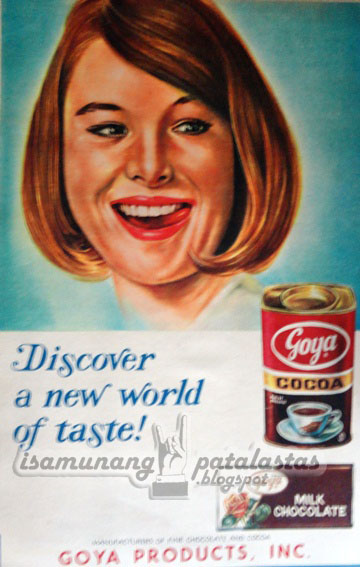 |
| GOYA OMNIBUS CHOCOLATE DRINKS, 1968 |
One of the more popular brands of made-in-the-Philippines chocolate products is GOYA, a joint venture started in 1956 by the enterprising Chua and Vilabrille families, under the company name GOYA Products, Inc. The first products were actually coffee and cocoa powder mixes. The cocoa line proved to be more viable, so GOYA expanded to making instant chocolate mixes and chocolate-flavored beverages. Eventually, GOYA would extend its line to include chocolate bars and confections that proved to be successful, favored for its affordable price and chocolatey goodness.
 |
| FROM COCOA DRINKS..TO MILK CHOCOLATE TREATS, 1967 |
This led
to Nestlé acquiring the local company in 1996, and was promoted actively
through seasonals and regular advertising. Eight years later, in 2006, Petra
Foods, a Singaporean food company —now known as Delfi Limited--- bought GOYA
from Nestle, which continues to oversee its manufacture and marketing
promotions in the Philippines, as well as in other Asian regions.
GOYA has had several relaunches, and is positioned to cater to the medium-end and lower-end brackets. But GOYA also has premium variety, a flanker product that is also part of the portfolio, and still affordably-priced.
 |
| GOYA ALMOND CRUNCH with a Toblerone-type packaging,1969 |
From the plain cube-sized chocolates, GOYA now produces dark chocolates, dark mint chocolates, white chocolates, almonds dipped in chocolates, crunchy bite-size chocolates and even choco-covered biscuits. GOYA is into spreads, syrups and baking ingredients too—so long as it’s got chocolates.
The
chocolate products are manufactured in a 3-hectare plant in Marikina City that
has been globally-certified for its quality and taste. The iconic GOYA is now a
heritage brand favored, recognized, and much-loved by generations of Filipino chocolate
lovers. The GOYA brand continues to endure, providing chocolate enjoyment to
Filipinos young and old alike, that is envisioned by Delfi Ltd. to prosper and
grow even morem in the years to come.





